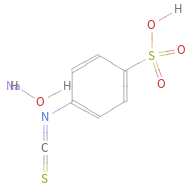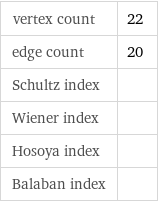Input interpretation

4-sulfophenyl isothiocyanate sodium salt monohydrate
Basic properties
![molar mass | 256.3 g/mol formula | C_7H_7NNaO_4S_2 empirical formula | O_4Na_S_2C_7N_H_7 SMILES identifier | C1=C(C=CC(=C1)S(=O)(=O)O)N=C=S.[Na].O InChI identifier | InChI=1/C7H5NO3S2.Na.H2O/c9-13(10, 11)7-3-1-6(2-4-7)8-5-12;;/h1-4H, (H, 9, 10, 11);;1H2/f/h9H;; InChI key | NCHUMJFHIHGJQD-UHFFFAOYSA-N](../image_source/2423d0dbdae7fb2f1a9966b8f712825b.png)
molar mass | 256.3 g/mol formula | C_7H_7NNaO_4S_2 empirical formula | O_4Na_S_2C_7N_H_7 SMILES identifier | C1=C(C=CC(=C1)S(=O)(=O)O)N=C=S.[Na].O InChI identifier | InChI=1/C7H5NO3S2.Na.H2O/c9-13(10, 11)7-3-1-6(2-4-7)8-5-12;;/h1-4H, (H, 9, 10, 11);;1H2/f/h9H;; InChI key | NCHUMJFHIHGJQD-UHFFFAOYSA-N
Structure diagram

Structure diagram
Quantitative molecular descriptors

longest chain length | 9 atoms longest straight chain length | 3 atoms longest aliphatic chain length | 0 atoms aromatic atom count | 6 atoms H-bond acceptor count | 5 atoms H-bond donor count | 2 atoms
Elemental composition

Find the elemental composition for 4-sulfophenyl isothiocyanate sodium salt monohydrate in terms of the atom and mass percents: atom percent = N_i/N_atoms × 100% mass percent = (N_im_i)/m × 100% Plan: • Write the chemical formula and gather atomic masses from the periodic table. • Determine values for N_i, m_i, N_atoms and m using these items. • Finally, compute the percents and check the results. Write the chemical formula: C_7H_7NNaO_4S_2 Use the chemical formula to count the number of atoms, N_i, for each element and find the total number of atoms, N_atoms, per molecule: | number of atoms O (oxygen) | 4 Na (sodium) | 1 S (sulfur) | 2 C (carbon) | 7 N (nitrogen) | 1 H (hydrogen) | 7 N_atoms = 4 + 1 + 2 + 7 + 1 + 7 = 22 Divide each N_i by N_atoms to calculate atom fractions. Then use the property that atom fractions must sum to one to check the work: | number of atoms | atom fraction O (oxygen) | 4 | 4/22 Na (sodium) | 1 | 1/22 S (sulfur) | 2 | 2/22 C (carbon) | 7 | 7/22 N (nitrogen) | 1 | 1/22 H (hydrogen) | 7 | 7/22 Check: 4/22 + 1/22 + 2/22 + 7/22 + 1/22 + 7/22 = 1 Compute atom percents using the atom fractions: | number of atoms | atom percent O (oxygen) | 4 | 4/22 × 100% = 18.2% Na (sodium) | 1 | 1/22 × 100% = 4.55% S (sulfur) | 2 | 2/22 × 100% = 9.09% C (carbon) | 7 | 7/22 × 100% = 31.8% N (nitrogen) | 1 | 1/22 × 100% = 4.55% H (hydrogen) | 7 | 7/22 × 100% = 31.8% Look up the atomic mass, m_i, in unified atomic mass units, u, for each element in the periodic table: | number of atoms | atom percent | atomic mass/u O (oxygen) | 4 | 18.2% | 15.999 Na (sodium) | 1 | 4.55% | 22.98976928 S (sulfur) | 2 | 9.09% | 32.06 C (carbon) | 7 | 31.8% | 12.011 N (nitrogen) | 1 | 4.55% | 14.007 H (hydrogen) | 7 | 31.8% | 1.008 Multiply N_i by m_i to compute the mass for each element. Then sum those values to compute the molecular mass, m: | number of atoms | atom percent | atomic mass/u | mass/u O (oxygen) | 4 | 18.2% | 15.999 | 4 × 15.999 = 63.996 Na (sodium) | 1 | 4.55% | 22.98976928 | 1 × 22.98976928 = 22.98976928 S (sulfur) | 2 | 9.09% | 32.06 | 2 × 32.06 = 64.12 C (carbon) | 7 | 31.8% | 12.011 | 7 × 12.011 = 84.077 N (nitrogen) | 1 | 4.55% | 14.007 | 1 × 14.007 = 14.007 H (hydrogen) | 7 | 31.8% | 1.008 | 7 × 1.008 = 7.056 m = 63.996 u + 22.98976928 u + 64.12 u + 84.077 u + 14.007 u + 7.056 u = 256.24576928 u Divide the mass for each element by m to calculate mass fractions. Then use the property that mass fractions must sum to one to check the work: | number of atoms | atom percent | mass fraction O (oxygen) | 4 | 18.2% | 63.996/256.24576928 Na (sodium) | 1 | 4.55% | 22.98976928/256.24576928 S (sulfur) | 2 | 9.09% | 64.12/256.24576928 C (carbon) | 7 | 31.8% | 84.077/256.24576928 N (nitrogen) | 1 | 4.55% | 14.007/256.24576928 H (hydrogen) | 7 | 31.8% | 7.056/256.24576928 Check: 63.996/256.24576928 + 22.98976928/256.24576928 + 64.12/256.24576928 + 84.077/256.24576928 + 14.007/256.24576928 + 7.056/256.24576928 = 1 Compute mass percents using the mass fractions: Answer: | | | number of atoms | atom percent | mass percent O (oxygen) | 4 | 18.2% | 63.996/256.24576928 × 100% = 24.97% Na (sodium) | 1 | 4.55% | 22.98976928/256.24576928 × 100% = 8.972% S (sulfur) | 2 | 9.09% | 64.12/256.24576928 × 100% = 25.02% C (carbon) | 7 | 31.8% | 84.077/256.24576928 × 100% = 32.81% N (nitrogen) | 1 | 4.55% | 14.007/256.24576928 × 100% = 5.466% H (hydrogen) | 7 | 31.8% | 7.056/256.24576928 × 100% = 2.754%
Elemental oxidation states

The first step in finding the oxidation states (or oxidation numbers) in 4-sulfophenyl isothiocyanate sodium salt monohydrate is to draw the structure diagram. Next set every oxidation number equal to the atom's formal charge: In 4-sulfophenyl isothiocyanate sodium salt monohydrate hydrogen is not bonded to a metal with lower electronegativity, so it will have an oxidation state of +1. Any element bonded to hydrogen gains the bonding electrons, decreasing their oxidation state by 1 for every bond: With hydrogen out of the way, look at the remaining bonds. There are 2 carbon-nitrogen bonds, 2 carbon-sulfur bonds, 3 oxygen-sulfur bonds, and 6 carbon-carbon bonds. For each of these bonds, assign the bonding electrons to the most electronegative element. First examine the carbon-nitrogen bonds: element | electronegativity (Pauling scale) | C | 2.55 | N | 3.04 | | | Since nitrogen is more electronegative than carbon, the electrons in these bonds will go to nitrogen. Decrease the oxidation number for nitrogen in every highlighted bond (by 1 for single bonds, 2 for double bonds, and 3 for triple bonds), and increase the oxidation number for carbon accordingly: Next look at the carbon-sulfur bonds: element | electronegativity (Pauling scale) | C | 2.55 | S | 2.58 | | | Since sulfur is more electronegative than carbon, the electrons in these bonds will go to sulfur: Next look at the oxygen-sulfur bonds: element | electronegativity (Pauling scale) | O | 3.44 | S | 2.58 | | | Since oxygen is more electronegative than sulfur, the electrons in these bonds will go to oxygen: Next look at the carbon-carbon bonds: element | electronegativity (Pauling scale) | C | 2.55 | C | 2.55 | | | Since these elements are the same the bonding electrons are shared equally, and there is no change to the oxidation states: Now summarize the results: Answer: | | oxidation state | element | count -3 | N (nitrogen) | 1 -2 | O (oxygen) | 4 | S (sulfur) | 1 -1 | C (carbon) | 4 0 | Na (sodium) | 1 +1 | C (carbon) | 2 | H (hydrogen) | 7 +4 | C (carbon) | 1 | S (sulfur) | 1
Topological indices

vertex count | 22 edge count | 20 Schultz index | Wiener index | Hosoya index | Balaban index |